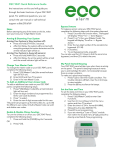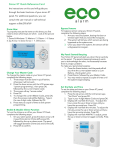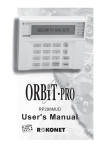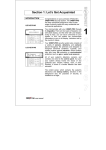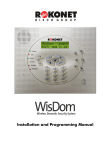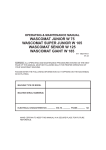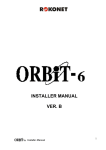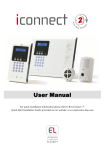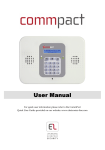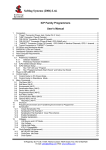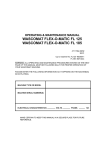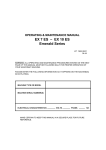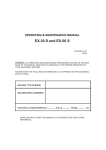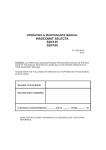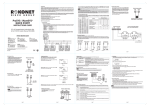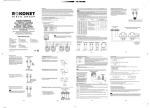Download ORBIT-6 User manual
Transcript
USER MANUAL VER. B User Manual 1 Customer Information 1. The ORBIT-6 (Model RP-206 ) complies with FCC Part 68 Rules. On the upper panel of this product is a label that contains, among other information, the FCC Registration Number and Ringer Equivalence Number (REN is 0.8B). If requested, this information must be provided to the Telephone Company. 2. An FCC compliant telephone connector is provided with this equipment. This equipment is designed to be connected to the telephone network or premises wiring using a connector, which is Part 68 compliant. 3. If the ORBIT-6 (RP-206 ) is not operating properly, it may cause harm to the telephone network. If so, the Telephone Company will notify you in advance that a temporary discontinuance of service may be required. If advance notice is not practical, you will be notified as soon as possible. Also, you will be advised of your right to file a complaint with the FCC if it is necessary. 4. The Telephone Company may make changes in its facilities, equipment, operations, or procedures, which could affect the operation of the equipment. If this happens, the Telephone Company will provide advance notice in order to enable you to make the necessary modifications to maintain uninterrupted service. If the equipment is causing harm to the telephone network, the Telephone Company may request that the equipment be disconnected until the problem is resolved. 5. Connection to telephone company-provided coin service is prohibited. Connection to party line service is subject to state tariffs. 6. If trouble is experienced with the ORBIT-6 (RP-206 ), for repair and warranty information, please contact your supplier. For service centers please see back cover. FCC Warning This equipment has been tested and found to comply with the limits for a Class B digital device pursuant to Part 15 of the FCC Rules. These limits are designed to provide reasonable protection against harmful interference in a residential installation. This equipment generates, uses, and can radiate radio frequency energy and, if not installed and used in accordance with the instructions, may cause harmful interference to radio communications. However, there is no guarantee that interference will not occur in a particular installation. If this equipment does cause harmful interference to radio or television reception, which can be determined by turning the equipment off and on, the user is encouraged to try to correct the interference by one or more of the following measures: • Reorient or relocate the receiving antenna. • Increase the separation between the equipment and the receiver. • Connect the equipment into an outlet on a circuit different from that to which the receiver is connected. • Consult the dealer or an experienced Radio/TV technician for help. Changes or modifications to this unit not expressly approved by Rokonet, Ltd., could void the user's authority to operate the equipment. p/n: 5IN206UM B 2 User Manual Copyright © 2000 by Rokonet Electronics Ltd., 14 Hachoma Street Rishon Letzion 75655 Israel All rights reserved. No part of this document may be reproduced in any form without prior written permission from the publisher. User Manual 3 Summary of User’s Commands It is necessary to ARM your system to obtain protection from intrusion. All other forms of protection, including fire and 24-hour panic alarms (i.e. police, fire, and special emergency) are always ready to report alarms and do NOT need to be armed. FUNCTION System Arming Stay Home Arming Instant Stay System Disarming Duress Disarming Silencing an Alarm Bypassing / Unbypassing a Zone Quick Bypassing Zone Reset Smoke Detector(s) Utility Output Operation Display Troubles Display Memory Setting/Changing a User Code Set Date Set Time *Set Auto Arm Time Set Follow-Me Phone No. 1 Set Follow-Me Phone No. 2 **Set Follow-Me Phone No. 3 **Set Follow-Me Phone No. 4 Maintenance: On/Off Buzzer On/Off Door Chime *On/Off Audible Kiss-Off Indication This User's Manual contains all the information needed to operate your Rokonet ORBIT-6 Security System and to get the most from it. This page, called a Command Summary, is intended to give you brief summaries of common system operations. More detailed explanations and related information can be found within, by referring to the indicated page. [USER CODE] + [ARM] [USER CODE] + [STAY] [STAY] + [STAY] [USER CODE] [DURESS CODE] [USER CODE] [ Q ] + [ 1] + [USER CODE ] + [ ZONE NUMBER TO BE BYPASSED / UNBYPASSED] [ZONE NUMBER TO BE BYPASSED] for at least 2 seconds [ Q ] + [ 2 ] + [USER CODE ] + [UTILITY OUTPUT NUMBER which is responsible for resetting the Smoke Detector] [ Q ] + [ 2 ] + [USER CODE ] + [ UTILITY OUTPUT NUMBER ] 4 Page 19 Page 19 Page 19 Page 22 Page 23 Page 22 Page 20, 25 Page 25 Page 25 Page 25 Page 26, [Q ]+[3] 29 [Q ]+[4] Page 26 [ Q ] + [ 5 ] + [MASTER CODE] + [CODE NUMBER TO BE Page 17, 26 SET/CHANGED] + [NEW CODE] [ Q ] + [ 6 ] + [ 1 ] + [MASTER CODE] + [MM] [DD] [YY] Page 26 [ Q ] + [ 6 ] + [ 2 ] + [MASTER CODE] + [H][H] [M][M] Page 26 [ Q ] + [ 6 ] + [ 3 ] + [MASTER CODE] + [H][H] [M][M] Page 26 [ Q ] + [ 7 ] + [ 1 ] + [MASTER CODE] + Phone No. + [#] Page 27 [ Q ] + [ 7 ] + [ 2 ] + [MASTER CODE] + Phone No. + [#] Page 27 [ Q ] + [ 7 ] + [ 3 ] + [MASTER CODE] + Phone No. + [ #] Page 27 [ Q ] + [ 7 ] + [ 4 ] + [MASTER CODE] + Phone No. + [ #] Page 27 [ Q ] + [ 8 ] + [MASTER CODE] + [ 1 ] [ Q ] + [ 8 ] + [MASTER CODE] + [ 2 ] [ Q ] + [ 8 ] + [MASTER CODE] + [ 3 ] Get Event From Event Logger [ Q ] + [ 9 ] + [MASTER CODE] + [EVENT NO.] [ Q ] + [ 0 ] + [MASTER CODE] Test System Trouble Table MORE ON PROCEDURE LED 1 2 3 4 5 Page 28 Page 28 Page 28 Trouble Low Battery AC Power Loss Clock/Date Not Set Communication Trouble Bell Loop Trouble User Manual Table of Contents SECTION 1: LET’S GET ACQUAINTED 7 Introduction 7 SOME DEFINITIONS 8 Zone 24-Hour Zone Day Zone Central Stations Chimes Trouble Reporting Utility Outputs Key-switch 8 8 8 8 8 8 8 8 SECTION 2: YOUR KEYPAD 9 Visual Indicators 9 Keys 11 SECTION 3: THINGS YOU SHOULD KNOW 13 ABOUT YOUR ORBIT-6 13 Arming Your System Full Arming and Home Arming Quick Arming and Code Arming Entry/Exit Delays Arming with the Front Door Open Sounder Cutoff The "Squawk" Feature Follow-Me Feature Voice Feature Zone Bypassing Duress Disarming Quick Bypassing and Code Bypassing 13 14 14 14 14 14 15 15 15 15 15 15 SECTION 4: OPERATING YOUR SYSTEM 16 Emergency Keys Police Emergency Fire Emergency 16 16 16 5 User Manual Special Emergency 16 User Codes 16 Setting/CHANGING THE MASTER/USER CODES 17 Deleting User Codes 18 ARMING YOUR SYSTEM 19 BYPASSING A ZONE Disarming an armed system Silencing an alarm in progress 20 22 22 Duress Disarming 23 SECTION 5: SYSTEM SOUNDS 24 SECTION 6: USER FUNCTIONS 25 Zone Bypassing Quick Bypassing Extra Quick Bypassing Activate a Utility Output Reset a Smoke Detector(s) Display System Troubles Display Alarm Memory Add, Modify, Delete User and Master Code(s) Setting the Date Setting the Time Set Follow-Me Phone Number 1 Set Follow-Me Phone Number 2 Keypad Sounder/ Chime Operation Event Logger System Testing 25 25 25 25 25 26 26 26 26 26 27 27 28 28 28 SECTION 7: SYSTEM TROUBLES 29 6 User Manual Section 1: Let’s Get Acquainted INTRODUCTION Congratulations on your purchase of Rokonet’s ORBIT-6 Security System. The ORBIT-6 has been specifically designed to meet a wide range of security needs for many residential and small commercial applications. You communicate with your ORBIT-6 through its keypad(s). Using its keys, you can issue commands to your system. In turn, the system can communicate information to you via its indicators and by the sounds it makes. Your ORBIT-6 security system also consists of a variety of sensors, detectors, and contacts placed throughout the premises and designed to recognize abnormal conditions. Typically, your system protects against intrusion. Some systems may also have fire protection or environmental protection (such as gas or water level sensors) All of your system's detectors, sensors, and contacts are wired to the control panel. As such, your system always knows the status of any protected door, window, hallway, room, or area. Similarly, it knows if a smoke detector has been activated. The control panel, which contains the system's electronics and backup battery, functions in the background and, for purposes of security, is installed out of sight. User Manual 7 SOME DEFINITIONS There are a few terms with which you should become familiar. Knowing them will help you to better understand and use your system Zone A single detector, or group of detectors, usually relating to a certain area of the premises or type of protection. Zones that use devices designed to detect break-ins, are called intrusion zones. Another kind of zone may contain one or more Smoke Detectors. Such zones are called fire zones. An environmental zone typically protects the premises from gas leaks and/or flooding. 24-Hour Zone A 24-Hour intrusion zone is always armed and is usually assigned to openings which should never be disturbed-like fixed glass and non-movable skylights. Day Zone A Day Zone is one in which a violation during the disarmed period results only in a keypad annunciation. However, the same violation during the armed period will cause a full-fledged alarm. Central Stations Besides producing audible alarms at your premises, it's likely that your system is set up to Central Station– continually monitors the activities of many security systems, usually via the telephone network, and Chimes The is a series of short keypad tones, which can be set up to annunciate, during the period, the violation of selected intrusion zone(s). The chime tone can be used to annunciate the opens. The chime can be disabled enabled at Trouble Reporting If desired, your security system may also report to troubles or malfunctions it Utility Outputs In addition to your system's normal operation, it's premises lighting under the control of the ORBIT6—where it can be conveniently turned on and off from any system keypad, or automatically activated in response to a system event. Key-switch 8 Your system may also be equipped with a keyswitch, useful for simple arming and disarming operations - usually at a remote location. User Manual Section 2: Your Keypad VISUAL INDICATORS The Orbit-6 can support 6 and 8 zone LED and LCD keypads. Both of these keypads have the same operating procedures. This section discusses the keypad's visual indicators and the use of its keys. Each keypad in your system reports its status via its LED (lighted) indicators at the right. Through its keys, you can enter commands to "arm" and "disarm" the system, bypass intrusion zones, report emergencies, silence an alarm in progress–along with several other useful functions. The four LED indicators found at the upper right provide typical system indications, as discussed below and on the next page. Some indicators have additional functions, explained later on. POWER LED The POWER LED is a useful indicator reflecting the system's operation. NOTE: If a trouble condition exists, the POWER LED will flash only when the system is in its disarmed state. Once the system is armed, a previously flashing POWER LED will light steadily. User Manual CONDITION (see note at left) EXPLANATION ON The system is operating properly from commercial (AC) power; its backup battery is in good condition. OFF The system is inoperative due to the lack of power (from both commercial AC and backup battery); servicing will be required. FLASHING Indicates a trouble condition; for more information on displaying and attending to trouble conditions, see pages 29 through 30. (disarmed state) 9 ARM LED The ARM LED indicates whether or not the system's intrusion detectors are armed. CONDITION EXPLANATION ON The system's intrusion detectors are armed; subsequent violations of a protected point or area (e.g. a door, a window, unauthorized motion) will result in a burglar alarm. OFF The intrusion function of the system is disarmed. FLASHING Occurs when using the emergency keys on the keypad to send panic, fire or special emergency alarm and also when viewing alarms after disarming. READY LED CONDITION The READY LED indicates whether or not the system's intrusion zones are secured and ready to be armed. EXPLANATION ON All intrusion zones are secure; the system is ready to be armed. OFF One or more intrusion zones are not secure and the system is not ready to be armed; before the system can be armed, the condition must be addressed (see pg. 20 through21). FLASHING Indicates that one or more of the system's intrusion zones have been bypassed; for more information on bypassing (see pages 20 through 21). FIRE LED CONDITION When lit, the FIRE LED indicates that the system is experiencing a fire alarm. When flashing, a problem has been detected on the fire circuit, and must be serviced. 10 EXPLANATION ON A fire alarm or fire emergency is in progress or has recently occurred. OFF All fire zones are operating normally. FLASHING A fault has been detected in the system's fire zone and needs to be corrected; for more information on fire zone trouble (see page 29). User Manual ZONE LED CONDITION The ZONE LEDs indicate the status of each of the system’s intrusion zones. OFF FLASHING ON KEYS EXPLANATION SYSTEM DISARMED The corresponding zone is secured. SYSTEM ARMED The corresponding zone is secured. The indicated zone is not secured. N/A N/A An alarm has occurred on the indicated zone. The keys on the keypad can be used for a variety of functions. Each is explained below: Used to input the numeric codes which may be required for arming, disarming, triggering emergency alarms, along with several other special functions. Used to enter the User Functions mode (see pages 25 through 27). Used to arm the system's intrusion detectors to the "AWAY" mode (see page 13); it may be necessary to enter a numeric User Code before pressing the Arm key (see pages 13 and 19 for additional information). Used to arm the system's intrusion detectors to the "STAY" mode (see page 13); it may be necessary to enter a numeric User Code before pressing the Stay key (see pages 13 and 19 for additional information). User Manual 11 12 User Manual Section 3: Things You Should Know About Your ORBIT-6 Arming Your System Arming your system enables its intrusion detectors to trigger an alarm when violated. Remember, fire protection and the protection offered by the keypad's emergency keys are always armed and always available. If your system is equipped with environmental protection (e.g. gas and/or water level detection) it is always available too. Secured or Bypassed: Before you arm your system, all of its zones must either be secured or bypassed. The keypad's READY LED, if lit, indicates that all zones are secured. If the READY LED is not lit, a numbered LED corresponding to the unsecured zone(s) will be flashing. Before you can arm your system, the indicated zone(s) must be identified and secured. If this is not possible, the affected zone(s) can be bypassed and will be ignored by the system during the subsequent armed period. Recall that bypassing, however necessary, reduces the system's degree of intrusion protection. User Manual 13 Full Arming and Home Arming Quick Arming and Code Arming Entry/Exit Delays Arming with the Front Door Open Sounder Cutoff Panic Button 14 Your ORBIT-6 offers two kinds of system arming. Full Arming prepares all of the system's intrusion detectors to sound an alarm, if violated. It is most often used when the premises will be empty. Home Arming (or Stay Arming) allows individuals to remain inside and move about the premises even after the system is armed. Home Arming arms the perimeter detectors (e.g. door and windows), while leaving interior detectors (e.g. motion detectors) disarmed (bypassed). Your ORBIT-6 also offers two methods of arming. Quick Arming achieves the result with just the press of a single key (either or ). Code Arming requires that a valid Master Code or User Code be entered first. Whether or not your system permits Quick Arming was determined during its installation. Your security system must incorporate an Entry/Exit Delay to allow proper entry and exit to and from the premises without causing inadvertent alarms. A delay period was chosen during your system's installation to provide suitable time to allow for your entry and exit. If set up by your alarm company, the ORBIT-6 allows you the convenience of arming your system with the front door either closed or open, after which you must close the door as you leave the premises before the exit delay period expires. With such a door open (and all other zones secure), the system is considered "ready to arm"; the Zone LED corresponding to the opened door will be lit, as will your keypad's READY LED. It's likely that your security system was installed with a sounding device (e.g. a siren or a bell). Typically, all sounding devices have cutoffs; that is, they will shut off after a predetermined interval (usually several minutes) set by your alarm company. In many locales, this is required by law. Once a sounder shuts off, it is still capable of responding to a subsequent alarm during the same armed period. A special panic button can be installed at any preferred location, to allow immediate and flexible alarm notification in time of distress. User Manual The "Squawk" Feature Follow-Me Feature Voice Feature Zone Bypassing Duress Disarming Quick Bypassing and Code Bypassing A feature known as Bell Squawk is available for your system. If selected by your alarm company, the Bell Squawk causes the system's external sounder (either a siren or a bell) to produce a momentary "beep" as follows: One beep: At the conclusion of the Exit Delay, confirming that the system has been successfully armed. Two beeps: Confirming that the system has been disarmed . Four beeps: Confirming that the system has been disarmed after an alarm has occurred. In case of an alarm event a phone call can be made to a predefined phone number. There are three different tone types that represent burglary, fire and special emergency alarms. The Follow-Me function can support two phone numbers. An optional Voice Module can be added to your system. Up to 3 short messages can be recorded. These messages replace the alarm tones normally produced in the follow-me mode. It may be convenient to have one (or more) of the zones in your installation bypassed–and thus ignored by your system. If you are ever coerced into disarming your system, you can comply with the intruder's wishes while sending a silent, duress alarm, to the Central Station. To do so, you must use a special Duress Code. Which when used, will disarm the system in the regular manner, while simultaneously transmitting a silent alarm to the central station. Your Orbit-6 offers two methods of Bypassing: Quick Bypassing achieves the result by pressing the key number corresponding to the zone to be bypassed for 2 seconds. Code Bypassing requires a valid Master Code or User Code to be entered first. Whether or not your system permits Quick Bypassing was determined during its installation. User Manual 15 Section 4: Operating Your System In this section, you'll learn how to perform most of the functions needed to properly operate your ORBIT-6 and to get the most out of your security system. EMERGENCY KEYS Your keypad provides three sets of keys, which can be pushed at any time the police, fire department, or special emergency is required. Panic Key Pressing and simultaneously, and for at least two seconds, will activate a Panic Key alarm. Fire Emergency Pressing and simultaneously, and for at least two seconds, will activate a Fire Emergency alarm. Special Emergency Pressing and simultaneously, and for at least two seconds, will activate a Special Emergency alarm. The annunciation that results during these emergency alarms, along with other system sounds, is covered in Section 5. USER CODES To perform many of the ORBIT-6's functions, a four-digit security code (often called a User Code) must be entered at the keypad. In residential systems, it's likely that all family members will share the same User Code. In certain commercial systems, however, it's common to give each authorized employee his/her own User Code (discussed on page 17). Your ORBIT-6 permits up to ten User Codes. One of the codes is considered the Master Code; the individual(s) using the Master Code is given the following special privileges: • adding, modifying, and deleting User Codes • setting the system's internal clock • performing certain system functions and tests Except for these considerations, the Master Code and any User Codes assigned to the system operate identically. Your ORBIT-6 was given a Master Code of 1–2–3–4 during manufacturing. Unless your alarm company has already changed it to suit your preference, it's best to modify this code to one which is unique and personalized. To change the Master Code, and/or to set up User Codes, follow the steps on page 17. 16 User Manual SETTING/CHANGING THE MASTER/USER CODES STEP DESCRIPTION 1 The system must be disarmed (the ARMED LED will be OFF). Enter the User Functions Mode ( Codes (5): 2 Enter the current 4-digit Master Code: 3 To change the Master Code, press "0": ) and select To enter/change the User Code 1, press "1": To enter/change the User Code 2, press "2": To enter/change the User Code 3, press "3": It is possible to enter/change up to 9 User Codes. 4 Enter the new 4-digit code selected for the Master Code or for the User Code of your choice: 5 If successful, the keypad will emit a one-second confirming tone. The selected User Code is now in effect. Example: To change the Master Code 1234 to a new code 7890, press the following keys: [Q][5] [1] [2] [3] [4] [0] [7] [8] [9] [0] 14243 14243 1442443 Master Code Code I.D. New Code to be changed User Manual 17 DELETING USER CODES At times, it may be desirable to completely delete a User Code. Note that it is impossible to delete the Master Code (although it can be changed). STEP 1 DESCRIPTION The system must be disarmed. Enter the User Functions Mode ( ) and choose Codes (5): 2 Enter the current 4-digit Master Code: 3 To delete the User Code 1, press "1": To delete the User Code 2, press "2": To delete the User Code 3, press "3": 18 4 Enter 0-0-0-0 (which is NOT a valid code) to clear the selected User Code. 5 If successful, the keypad will emit a one-second confirming tone. The selected User Code is now deleted. User Manual ARMING YOUR SYSTEM STEP 1 DESCRIPTION Check the READY LED on your keypad. If lit or flashing, the system is READY. If NOT lit or flashing, the system is NOT ready to be armed. Secure or bypass the violated zone(s) and then proceed. Arming when Leaving the Premises Empty: Away Arming . Enter the four digits of your User Code and press 2 NOTE: If you make a mistake when entering your User Code, the keypad will produce three short beeps. If so, reenter the above sequence correctly. If your system has Quick Arming, simply press Leave the premises and close the door. The keypad will beep as counts down the Exit Delay period. 3 Arming with the Premises Occupied Enter the four digits of your User Code and press Stay Arming 2 . NOTE: If you make a mistake when entering your User Code, the keypad will produce three short beeps. If so, reenter the above sequence correctly. If your system has Quick Arming, simply press . If required, leave the premises and close the door. The keypad will beep as it counts down the Exit Delay period. The internal zones will be automatically bypassed. 3 Note: By pressing (twice) the system will silence the beeps on the keypad and cancel the entry delay time. By pressing keypad. User Manual during exit time will silence the beeps on the 19 BYPASSING A ZONE STEP 1 Code Bypassing DESCRIPTION Check the READY LED on your keypad. If NOT lit or flashing, the system has at least one faulted intrusion zone identified by noting which LED(s) are flashing in the keypad's ZONES area, shown at the left. To bypass such a zone(s) and cause it to be ignored by the system, enter the following sequence correctly: 2 NOTE: If you make a mistake when entering your User Code, the keypad will produce three short beeps. Re-enter if necessary. An additional zone(s) can be bypassed at the same time by adding its number to the sequence. For example, to bypass Zones 2 and 3, press: [ ] + [ 1 ] + [USER CODE] + [ 2 ] + [ 3 ] The same sequence can “toggle” the bypass(es) during the disarmed period so that they may be either applied or removed. Press # or Q to approve or wait 2 seconds (timeout period). 20 User Manual BYPASSING A ZONE (CONT.) If the system is programmed for quick bypass the following option is available: Quick Bypass To bypass a zone simply press the corresponding keypad number for at least 2 seconds. 2 An additional zone(s) can be bypassed at the same time by adding its number to the sequence. For example, to bypass Zones 2 and 3, press: [ 2 ] for 2 seconds + [ 3 ] The same sequence can “toggle” the bypass(es) during the disarmed period so that they may be either applied or removed. 3 The READY LED, when flashing, indicates that there is one or more bypassed zones. Any zone(s) bypassed during the disarmed period will remain bypased when the system is armed. Zone(s) that are bypassed, during the time the system is armed, will automatically be restored to its normal, unbypassed condition, when the system is disarmed. DETERMINING WHICH ZONE(S) IS BYPASSED STEP 1 2 DESCRIPTION The system must be disarmed. If the keypad’s READY LED is flashing, there is at least one bypassed zone, in the If quick bypass is enabled in your system. To determine system, simply press: which zone is bypassed, follow this sequence: Observe the keypad’s ZONES area. LED(s) corresponding to the bypassed zone(s) will light for several seconds. User Manual 21 DISARMING AN ARMED SYSTEM AND/OR SILENCING AN ALARM IN PROGRESS STEP DESCRIPTION 1 If outside the premises, open an "entry" door; the keypad(s) will beep indicating that the Entry Delay period has begun. Disarming an armed system Before the Entry Delay expires, enter the four digits of your User Code. 2 NOTE: If you make a mistake when entering your User Code, the keypad will produce three short beeps. If so, re-enter the above sequence correctly. 2 Silencing an alarm in progress Observe the keypad. If any of the following conditions is evident, an alarm has occurred: ·• the ARM LED is flashing ·• a Zone LED is lit steadily ·• the FIRE LED is lit steadily Disarm the system by entering your User Code: It's best to enter the premises only after police or a security company has investigated and you feel confident that the burglar is no longer on your premises. 3 22 IMPORTANT! If the alarm was caused by a tripped Smoke Detector(s), the keypad's FIRE LED will remain lit—providing an indication that the fire system must be reset before it will be capable of detecting subsequent alarms. Furthermore, until reset, you will be prevented from arming your system. To reset the fire system and to turn off the FIRE LED, refer to Activate a Utility Output/Reset Smoke Detectors, in the table on page 25. User Manual DURESS DISARMING All 10 user codes can activate the Duress disarming by adding 1 to the last digit of your user code. Example: if your code is 1-2-3-4 your duress code is 1-23-5 If your user code is 5-6-7-0 your duress code is 5-6-7-1 Note: Under no circumstances must the Duress Code be used haphazardly or without reason. Central Stations, along with Police Departments, treat Duress Codes very seriously and take immediate action. DISARMING BY USING THE DURESS CODE STEP 1 2 DESCRIPTION If outside the premises, open an "entry" door. The keypad(s) will beep indicating that the Entry Delay period has begun. Enter your 4-digit Duress Code: Once entered, it will disarm your system and send a silent alarm to the Central Station. A utility output in your system may be programmed to be activated continuously after an entry of the duress code. If so, deactivation must be done manually by one of the following procedures: 1. Arming the system. 2. Disarming the system after an alarm that occurred while the utility output was still activated. User Manual 23 Section 5: System Sounds Besides the visual indications provided by your keypad(s), your system is designed to produce audible annunciation after certain events. Depending on the circumstance, such sounds may be made by your system's keypad(s), its external sounder (e.g. a siren or bell), EVENT NOTE 1: If selected during the installation, a brief "chirp" may be heard from Intrusion Alarm the siren when the Exit Delay period expires. See page 14 for additional information. Fire Alarm NOTE 2: Whether or not the Police Emergency alarm is annunciated by the external sounder is determined by the alarm company during your system's installation. NOTE 3: Keypad beeps in response to Entry/Exit Delay countdowns, Keypad Fire Emergencies, and keypad errors and confirmations are typically enabled. At the user's discretion, such beeps may be disabled. See page 14 for additional information. NOTE 4: Any intrusion zone, if selected for the chime feature, will, when violated during the disarmed period, cause the keypad to annunciate the event (see page 8). Through User Functions (see page 27), the chime can also be disabled when not desired. NOTE 5: Based on decisions made at the time your alarm system was installed, keypad(s) may beep during this type of alarm. KEYPAD SOUND SIREN/ BELL YES MAYBE (see Note 5) (continuous) Rapidly repeating tones (see Note 3) (staggered) YES Keypad Police Emergency A momentary chirp Keypad Fire Emergency Rapidly repeating tones (see Note 3) Keypad Special Emergency A momentary chirp no sound Arming or disarming A one second tone if completed correctly; three rapid error beeps if incorrect (see Note 3) no sound Entering an incorrect key sequence Entry Delay countdown OPTIONAL (see Note 2) YES Three rapid beeps no sound (see Note 3) Slowly repeating tones until the entry delay period expires (see Note no sound 3) Exit Delay countdown Slowly repeating tones OPTIONAL until the exit delay period expires (see Note (see Note 1) 3) Entering data into the User Functions mode A one second tone if completed correctly; three rapid error beeps if incorrect (see Note 3) no sound (see page 25) 24 User Manual 0 Section 6: User Functions Your ORBIT-6 comes with a variety of selectable User Functions. By entering the User Functions mode, a number of options become available which determine how your alarm system operates, such as: • adding, modifying, and deleting User Codes • bypassing zones • displaying a "memory" of previous alarms • displaying system troubles • disabling (and re-enabling) keypad sounds • setting the system's internal clock, time and date • performing certain system tests Among these User Functions are some which have already been covered. As required, each will be explained below. USER DESCRIPTION PRESS COMMENTS FUNCTION Zone Bypassing + + USER CODE + (zone number to be bypassed or unbypassed) Quick Bypassing To bypass or unbypass a selected zone(s) Extra Quick Bypassing Activate a Utility Output Reset a Smoke Detector(s) + + (zone number to be bypassed or unbypassed) Refer to Zone Bypassing procedures, already discussed on page 20. for at least 2 sec. (zone number to be bypassed or unbypassed) To activate or deactivate a Utility Output To reset a Smoke Detector + + USER CODE + (Utility Output number to be activated or deactivated) + + USER CODE + (Utility Output number responsible for resetting the Smoke Detector(s) User Manual Refer to Utility Outputs on page 8; also consult your security dealer. Refer to System Troubles on page 29; also consult your security dealer. 25 USER FUNCTION Display System Troubles Display Alarm Memory DESCRIPTION PRESS Display system problem(s) causing the POWER LED to flash + Reviews any alarms occurring during the last armed period + Add, Modify, Delete User and Master Code(s) + + MASTER CODE + COMMENTS Refer to System Troubles on page 29. Via its LEDs, the keypad reveals the zone(s) in which an alarm occurred during the previously-armed period. After several seconds, the LEDs will restore to normal. Refer to Setting / Changing Master / User Codes, discussed on page 17. (number of the Code to be added, modified, or deleted) + (the new 4-digit code) NOTE: Use 0-0-0-0 to delete the Code. Setting the Date Set the systems date Setting the Time Sets the system’s internal clock + + MASTER CODE D + + D + Y Y + + MASTER CODE + enter time in HH:MM format Setting the Auto Arm + To enter date as: MM DD YY MM: month 1-12 DD: Day 1-31 Year: 00-99 Use 24-Hour format, as in these examples: • for 12:30 AM, enter 0030 • for 8:45 AM, enter 0845 • for 6:15 PM, enter 1815 the clock must be set to insure proper system operation. Use 24-Hour format. + MASTER CODE + enter time in HH:MM format 26 User Manual USER FUNCTION DESCRIPTION PRESS or Set FollowMe Phone Number 1- 4 Sets the first phone number for the follow-me function (up to 24 digits) or or COMMENTS + Enter the phone number in the same manner as MS number during installation. + + + + MASTER CODE + Phone Number + [#] FUNCTION stop dialing and wait for a new dial tone wait a fixed period before continuing switch from Pulse to Tone (or from Tone to Pulse) * If required, include the following special functions to achieve the effect listed in the table: SEQUENCE [STAY], [1] [STAY], [2] [STAY], [3] RESULTS A B C send the DTMF Q character [STAY], [*] * send the DTMF # character [STAY], [#] # User Manual 27 USER FUNCTION DESCRIPTION Keypad Sounder/ Chime Operation/ Audible Kiss-Off Indication Determines how the keypad's internal sounder will operate under specific conditions Event Logger Retrieves events located in the event logger memory (up to 99 events). System Testing Provides a brief test of the following: ·• keypad LEDs ·• keypad sounder ·• external siren ·• standby battery 28 PRESS COMMENTS After entering the Master Code, press to enable/disable current operation of keypad's + beeps (see Note 3 on + MASTER CODE page 24) . Press to disable/enable the + / OR "chime" for intrusion zones having this + / OR feature (see page 8). Press to disable/enable the Audible Kiss-Off Indication. The event number is represented by the + LEDs (events are + MASTER CODE zone presented from the + Event Number last entered to the first registered). The external sounder will be activated momentarily. • The keypad's LEDs will flash. • If enabled, the + keypad's sounder will beep. + MASTER CODE • A low battery (see pages 8 and 29) or a loss of commercial power will cause the POWER LED to flash; if so, consult your security dealer. User Manual Section 7: System Troubles Your ORBIT-6 is designed to report any troubles or malfunctions it may detect. Notification that a problem exists is made to the user, through indications on the keypad(s) and, in many cases, to the Central Station and to your dealer. Any incidence of trouble should be taken seriously and acted upon immediately. If not remedied quickly, a trouble condition will likely compromise your system and prevent it from properly doing its job. The ORBIT-6 is designed to be as trouble-free as possible. Were a problem to develop, the POWER LED will flash about once every second. If so, to determine the problem, perform the sequence on the following page. In certain cases, the keypad's FIRE LED may remain lit steadily, even though there is no alarm in progress and the system is disarmed. Refer to the explanation and remedy below: USER FUNCTION DESCRIPTION AND REMEDY After a fire alarm has occurred and been silenced, the keypad's red FIRE LED will remain lit steadily if a Smoke Detector (presumably the one which caused the alarm) remains tripped. Until reset, a tripped Smoke Detector will prevent the READY LED from being lit, and will NOT permit the system to be armed. the FIRE LED To reset a tripped Smoke detector and to extinguish the red remains lit FIRE LED, follow this procedure, which is typical: + + USER CODE + 64444744448 UTILITY OUTPUT NUMBER (which is responsible for resetting the Smoke Detector) Consult your security dealer for alternate information on resetting smoke detectors, if applicable. Once done, the READY LED will indicate the system's status and you will be able to arm your system. User Manual 29 IDENTIFYING SYSTEM TROUBLES STEP DESCRIPTION 1 Perform if the POWER LED is flashing. If lit steadily, there are no system troubles. To view trouble conditions, the system must be disarmed. Enter the User Functions Mode by pressing [ ] and then select View Troubles (3): 2 The keypad will beep and its LEDs will light, reflecting the information below. After several seconds, the display will return to normal. 3 FLASHING: Trouble Detected OFF: (normal in this mode) OFF: (normal in this mode) IF ON: Fire Zone Trouble (contact your dealer) IF ON: IF ON: Low Battery (contact dealer) AC Power Loss (see Note 1) IF ON: Clock, Time & Date Not Set (see page 19) Communications Trouble (see Note 2) Bell Loop Trouble (see Note 3) IF ON: IF ON: In an 8 zone keypad there are 2 more LEDs which are only zone indicators and not system indicators. NOTE 1: Check that the ORBIT-6's Plug-In Transformer has not been removed from its outlet. If intact, check that a blown fuse, a switch, or a tripped circuit breaker has not interrupted the circuit supplying power to the transformer. NOTE 2: The ORBIT-6 has failed in its attempts to report an alarm or trouble condition to the Central Station. Check that your telephone line is functioning. Check to see if your external bell has been tampered with. If the problem still exists contact your dealer. NOTE 3: The ORBIT-6 has failed in its attempt to identify the Bell Loop. It is possible for more than one trouble to be present at the same time. If so, multiple Zone LEDs will be lit simultaneously. 30 User Manual EMERGENCY EVACUATION PLANS An emergency evacuation plan should be established and used during an actual fire alarm condition. The following steps are recommended by the National Fire Protection Association (NFPA) and can be used as a guide when establishing a similar plan for your circumstances. 1. Draw a floor plan of your premises showing windows, doors, stairs, and rooftops, which can be used for escape. An example has been provided below. 2. Indicate each occupant's escape routes by determining two means of flight from each room. One should be the normal exit from the building, while the other may be a window that opens easily, or another alternate route. An escape ladder may have to be located near an escape window if there is a long drop to the ground below. Always keep escape routes free from obstruction. 3. Practice escape procedures and set a meeting place outdoors for a headcount of the building's occupants. 4. In a home, sleep with the bedroom door closed to increase your escape time. If a fire is suspected, first test the door for heat. If you think it is safe, brace your shoulder against the door and open it cautiously. Be ready to slam the door if smoke and heat rush in. 5. After escaping from a fire, call the Fire Department from a neighbor's phone. After the installation of your Security System has been completed, notify your local Fire and Police Departments to give them your name and address for their records. Early warning fire detection is best achieved by the installation of fire detection devices in all rooms. This equipment should be installed in accordance with the National Fire Protection Association's Standard 72. For additional information, write to the National Fire Protection Association (NFPA) at Batterymarch Park, Quincy, MA 02289. User Manual 31 Notes 32 User Manual
































